Highlights
- Member recognizer to convert solids and or parts of solids into analysis objects
- Align functionality helps you build an analysis model without losing control
- Clash check to detect design flaws
- Update feature to manage external changes in the project
There is an important difference between the way an architect an an engineer perceive a model.
Whereas the architect is primarily looking at form and function, the engineer is interested in the structural part of the model
Architectural model and structural model are complementary - one can not exist without the other.
For the engineer a third type of model emerges: the analysis model.
The analysis model is a simplified version of the structural model and consists of just enough information to perform the analysis.
E.g. a structural beam is represented as a centerline with a corresponding cross section in the analytical model.

The biggest difference however lies in the connection of the entities. In the analysis model members must connect in nodes.
SCIA Engineer is unique is this way that it allows the engineer to define a relation between the real shape (structural model) and the analysis model. The user will decide which of the two is the primary one. The other is automatically generated by SCIA Engineer.
Having both structural as analysis model available in the same software has many advantages, especially in a BIM (Building Information Modelling) process
When you set up an analysis model in SCIA Engineer the software produces the structural model at the same time. Every structural model you create will automatically have an analysis model.
The story is somewhat different when you receive an external structural model. This could be a solid model (DWG), an IFC (neutral ISO format) or a model imported via a proprietary link.
An engineer can cope with this imported model as a mere reference model and create his analysis model on top, using the reference model as snaps.
Another approach is to reuse the imported model and derive the analysis model out of the structural one.
Deriving an analysis model consists of 2 steps
- convert structural entities into analysis members
- align and connect the members
This is where our BIM Toolbox comes in.
The BIM Toolbox is a set of commands which make it easy for an engineer to generate an analysis model
The BIM Toolbox consists of
- Member recognizer
- Align routine
- Clash check
- Update
Convert
Our member recognizer allows you to turn a general solid into a 1D (beam / column) or 2D (wall / plate) entity. You can even turn a part of a solid into an analysis object.
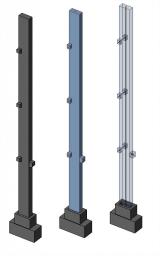
Similarly you can use this tool to turn an analysis object into a general solid. This is particularly useful when you want to turn a 1D member into a 2D member or vice versa.
Here you see - from left to right - a general solid, the converted entities as surface model and the wire-frame model
Models built up out of standard beams, columns, slabs and walls are relatively easy to transfer between different types of software.
When it comes to complex shapes a supplementary tool is needed to identify these shapes and to translate them into an equivalent object.
SCIA Engineer's Member Recognizer can also deal with more complex shapes and cross-sections and transform them into 1D or 2D elements.
Align
Alignment is a technique in which the analysis objects are modified in order to obtain a model which can be analyzed.
Often this means members are extended, shortened or moved in order to connect to other members.
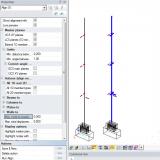
SCIA Engineer offers you a straight forward graphical approach, using master planes, where the user can preset the actions and preview the result
Once the user is satisfied with the preview, he can run the alignment as such. The result is a nicely connected analysis model, parallel to the unchanged structural model.
Aligning structures is mostly not a single button solution. Deriving a correct analysis model from a structural one requires the right skills and depends strongly on the hypothesis of the structural engineer.
It's good to know that the BIM Toolbox is able to support you in this. You can easily split up the alignment in several steps, each with different parameters.
Compare it with an à la carte menu where you go through all the courses and finish with the icing on the cake: your analysis model.
In the align command you have 2 more tools at your disposal:
- Connect members/nodes
- Check structure data
The Connect command helps you in really binding the whole model together. Additional nodes will be generated in the intersections of 1D and 2D members, allowing you to evaluate the results in those spots.
Check Structure Data is a quality assurance tool which will verify whether your model meets the required prerequisites for analysis. Duplicate or free nodes are removed, data references are checked and additional data verified.
Clash Check
Rework is currently a quite important part of the construction industry. Using 3D models a lot of design flaws can be avoided, that is when you have the right tools at your disposal to detect them.
The Clash check command in SCIA Engineer allows you to find all collisions in a selection or find clashes between a first set and a second set of elements.
The clashes are listed in tree-like navigator and visually represented by means of collision objects
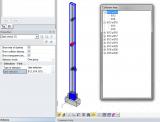
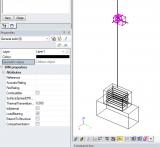
Update
Revisions are common practice in projects. External changes might affect your project as well. That's why SCIA Engineer is equipped with an Update tool.
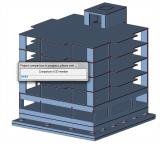
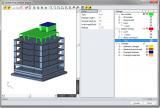
You can update a project in SCIA Engineer with data from different origins. You can use another ESA project but even so an IFC, XML, Revit or Tekla file
The sequence is very user friendly. Upon update the old and new model are compared by SCIA Engineer
A manager displays the current model and the model to be imported. You can distinct between existing, changed and deleted entities.
Properties of every item you select will be displayed in the window
Check boxes help you to decide on whether or not to accept all or a selection of the changes.
Conclusion
All the tools above are the key to deriving a correct analysis model from imported reference models.
What makes SCIA Engineer really unique is being able to import virtually any geometry (IFC, DWG,...), no matter which software it originates from, and turn it into a analysis model without much effort.
Our Open BIM approach allows you to keep the imported model for mere reference or reuse the imported entities as such.
Boost your performance in BIM and use the SCIA Engineer BIM Toolbox.

Want to try SCIA Engineer yourself?
Explore how our software and services can help you optimise your work and boost your productivity. Try it for yourself with a free 30-day software trial.
Download a free 30-days full trial